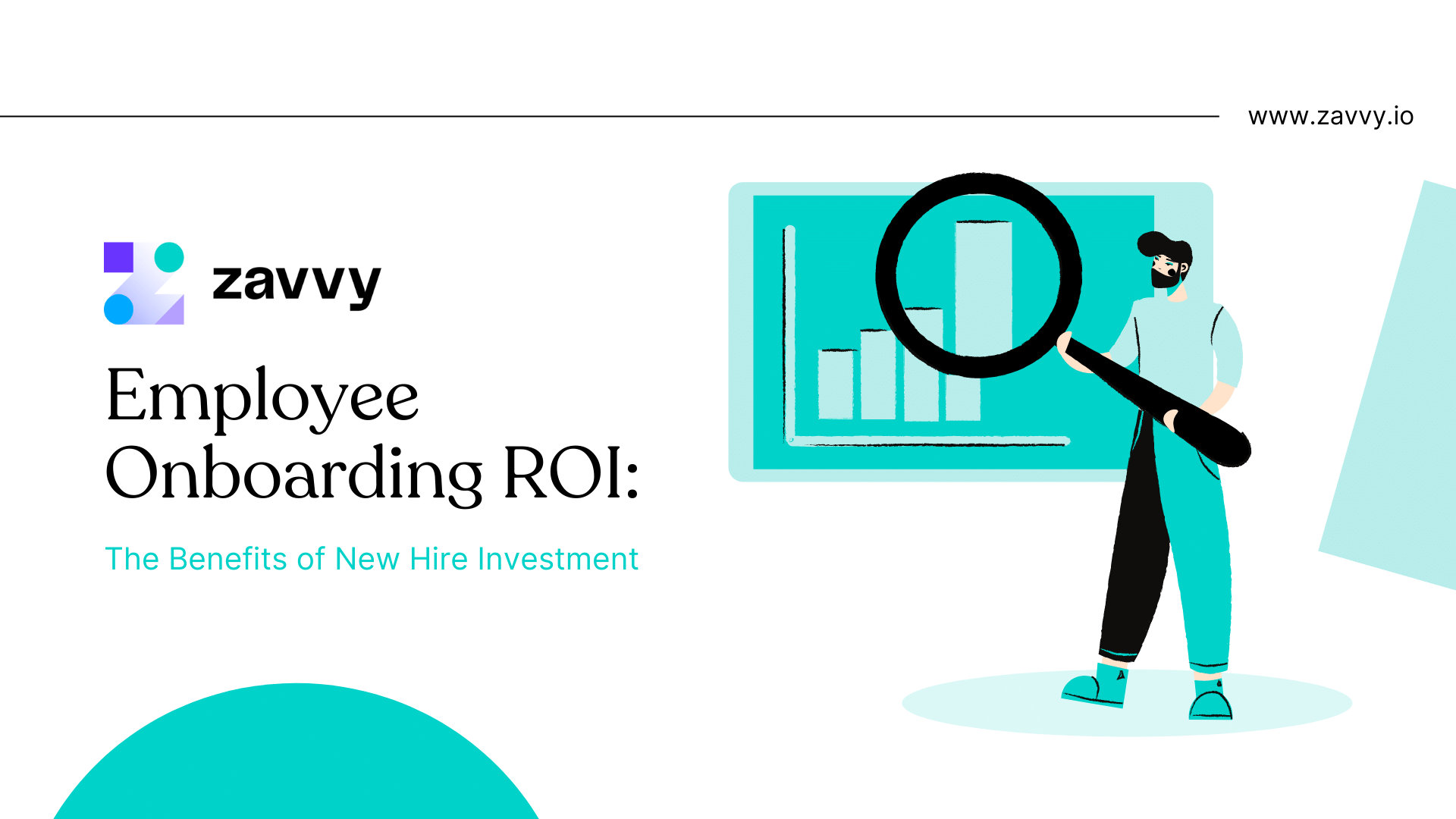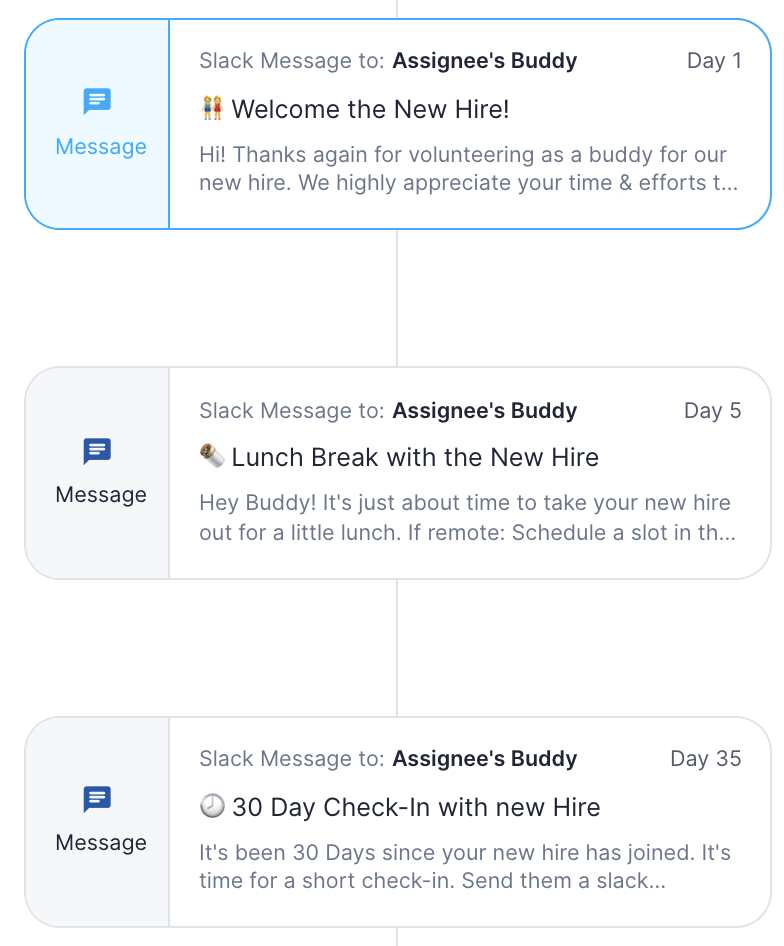
Alexander Heinle
Alex is a marketer at Zavvy. On this blog, he mainly shares insights gained from discussions with selected experts and from helping our customers set up and improve their onboarding or learning programs.


An effective onboarding process goes beyond shoving a bunch of benefits into your employees' arms and showing them around your fancy organization. You could go through all that trouble and they still won't feel excited about their new job.
If the onboarding process feels like a routine and has no clear objectives, it will fail to properly integrate employees into organizational cultures and operations. As a result, 25% of them will leave before the year runs out.
A great onboarding process ensures that employees
This post touches on its focus points and how they translate to greater Return On Investment (ROI).
Together with our curators, we have created a library of actionable digital marketing resources. Personalized to your team's needs.

Factors that influence ROI are things like
We discuss them as solid pillars of employee onboarding ROI in a future section.
But first, what is employee onboarding ROI?
Onboarding is the process of integrating new employees into an organization. It involves introducing them to coworkers and clients, training them, giving them a tour of facilities, and a series of other activities.
The purpose of onboarding is to help employees understand their new position and equip them to perform well in their jobs.
The ROI of onboarding is the money you get back when employees start making a profit and producing innovative results for the organization.
Simply put, employee onboarding ROI refers to money earned from investing in onboarding processes.
Here are four key metrics you can use to get an estimate of your onboarding ROI:
Effective onboarding strategies keep your employees from running out the door within the first few months. This can avoid costly turnover rates for organizations.
When an employee quits, it costs 20% of their salary to replace them with someone new. With a poor onboarding strategy in place, you're more likely to experience higher turnover rates. This will make it impossible to pool in any ROI.
An effective onboarding strategy is characterized by an immersive experience. It's not just managers telling recruits, "here's what you should do. Call me if you need anything," and then abandoning them. Later on, the employee begins to spam them with cries for help or assistance.
Instead, there is a collaborative culture where everyone works together to create a meaningful experience. New hires understand their roles clearly, and how it aligns with the vision and mission of the organization. Expectations are defined, and rules guiding behaviors are set.
The faster you can make this happen, the quicker the employee becomes productive. That UI design project that normally takes one month will be done in three weeks.

Your bottom line simply means your net income.
It is the money that remains when you deduct every expense or cost from your total revenue—for example, taxes and loan charges. You should see the figures at the bottom of your income statement.
Without a quality onboarding process, employees will lack a proper understanding of the organization. They'll be cut off from the proper intellectual and physical resources they need for better performance. This equates to unproductive and disengaged workers.

Technology is rapidly changing how organizations operate. There's more pressure now than ever for employees to learn to adapt. Having a digitized onboarding process will prevent that from happening.
If you've been carrying over training strategies from nine or ten years ago, now is the time to spice things up. Here are five essential components for building your new onboarding strategy:

If you fail to prepare your employees, you're preparing them to fail.
Before the onboarding process, engage employees with activities that will give them a head start. It will save time and reduce the stress of the first day.
Here are a few ideas for preboarding activities:
The onboarding process is the first impression you make on new hires, so it's important to bring your A-game. Employees who experience an effective onboarding process become engaged and 18 times more committed to their organization. If the process is poor, you'll lose talent to the competition.
In the U.S., the average cost of replacing employees who quit is $15,000 per head, which accounts for 33% of the salary.
To build the dream onboarding process for employee, Co-Founder & CEO of Eterneva, Adelle Archer, says that:
"Looking at each hires personal strengths, understanding their interests, and using their goals as a metric, will provide the opportunity to tailor the onboarding process around your new team member, rather than trying to force company goals that will push them outside of their comfort zone.
By making the employee rather than the business the focus of your onboarding process, you will integrate them to the company, while using their talents to better the chances of success."
Some organizations make the mistake of not documenting their processes. For large organizations with geographically dispersed offices, this is a huge problem as there will be no uniformity. The onboarding process for one recruit today will be different for another tomorrow.
Every new hire should start with the same foundational information as their peers for smooth collaboration and efficiency.
Create a checklist. A checklist acts as a reminder of the activities you need to complete in their right order and stops you from going off-course.
Use automation. Record videos and design courses that will contain every information new hires need to know. Then upload them to your onboarding solution or Learning Management System (LMS) so employees can access them anytime.
Most LMS solutions are now cloud or web-based, so they can store your information securely and prevent data loss.
Storyblok saves 15+ hours every week by running an automated onboarding experience:

➡️ Case Study: How Storyblok went from 33 to 140 employees in 1 year
Ideally, employee onboarding should last for a minimum of three months. The remaining length of the program should be tailored to suit your organizational needs.
Organizations with many moving parts (multiple locations, storefronts, or sales territories) may find it difficult to reserve time for proper onboarding. Employees will then be pressured to finish their training and the process ends quickly.
Christa Reed, Head of Job Market Research at JobSearcher, offers the following tip on creating time for onboarding:
"Remember that the first few days of onboarding are a critical time for new hires. Make sure you give them your full attention and make them feel welcome.
One way to do this is by pairing the new hire with a peer buddy who can show them around, introduce them to key team members, and help them get settled into their new role. You should also provide the new hire with a detailed schedule of their first week, including when and where they need to be, so there are no surprises."

Pairing employees with a work buddy during their first 30-60-90 days will significantly affect their performance. Microsoft's buddy program is proof of this, as the managers take one-on-one interactions with new hires seriously.
Everyone gets assigned a work partner they can run to for informal help. This helps them build a support system and increase productivity. 56% of employees who met with their buddy just once within the first 60 days became productive faster. 97% of those who met more than eight times said the same.
Christen Steele, HR Recruitment Consultant, says that:
"The goal of creating a positive experience is to build connections with colleagues and company culture. This means that successful onboarding happens when new hires can establish effective working relationships early on. "
"Beyond the meals and coffee chats mentioned earlier, these can also include social media or communication channels like Slack, where employees can connect both personally and professionally. Here at Yello, we have Slack channels dedicated to pets, babies, sports, and other shared interests where we can share and have a space to ask questions, receive help, and simply connect."

Our research revealed these five strong Pillars that build up employee onboarding ROI:
Manual processes present bottlenecks and high risks of human error. For example, you accidentally send your personal checklist to new hires instead of the checklist of important documents they need to bring along.
Then your employee shows up at the office with the wrong documents in hand, causing delays on the first day. But what if they could do all these online?
Replacing traditional methods with automated tools eliminates such inefficiencies and streamlines the onboarding process. Tools like Zavvy would've helped you automatically schedule the correct email for delivery days before.
Organizations with effective onboarding processes witness 54% more profit than those without one. The time-to-productivity ratio is also higher. 77% of their employees reach their first milestone earlier than the expected period of eight months.
77% of employees quit because they feel like they're on their own in progressing their careers. This is one problem effective onboarding solves. It shows commitment to staff growth and makes employees feel supported.
Employees start to see themselves as one with the organization and become passionate about achieving its goals and objectives. Such employees will stay longer with the organization.
Netflix's company culture is characterized by free and open communication, no rules, and transparency. Employees gather knowledge outside their specialty, but overall, everyone is committed to doing what's best for the company because it also affects them.
One lesson you can learn from this is to build a culture that communicates your values. Encourage idea sharing by rewarding innovative contributions. Give effective feedback to help employees know what they're doing wrong or right.
Most importantly, showcase this culture during the onboarding process and maintain it long-term. It shouldn't be a one-time event that ends once new hires have learned the ropes fully.
All onboarding activities must follow due process. So it's essential to stay up-to-date about laws guiding employment around your region.
For example, the Immigration Reform and Control Act (IRCA) states that all U.S. employers must complete an I-9 form for anyone they hire. This form proves that your new employee is authorized to work in the U.S. Failure to do so attracts penalties and fines of $234 to $2,332.
Leveraging automation, enhancing your company culture, and automating activities are part of what shapes the dream onboarding process. Once executed properly, it can transform new employees into goldmines quickly. You can use an employee onboarding ROI calculator to measure the effectiveness of your strategy and determine your ROI.
Our new hire onboarding solution is equipped with templates and tools for building a scalable employee onboarding program. It provides a central platform where employees can start journeys, complete tasks, and connect with teammates for a hassle-free experience.
Our experts are available to help you learn more. Connect with them to see how it works.
.png)
Upskill your team every week with the best contents and personalized recommendations.

An effective onboarding process goes beyond shoving a bunch of benefits into your employees' arms and showing them around your fancy organization. You could go through all that trouble and they still won't feel excited about their new job.
If the onboarding process feels like a routine and has no clear objectives, it will fail to properly integrate employees into organizational cultures and operations. As a result, 25% of them will leave before the year runs out.
A great onboarding process ensures that employees
This post touches on its focus points and how they translate to greater Return On Investment (ROI).
Get a demo!
We'll be happy to show you around and answer all your questions.
Trusted by innovative companies



We'll be happy to show you around, answer your questions, or arrange a free trial.
Erhalten Sie eine kostenlose Demo unserer Onboarding-Software.
Vertraut von



Your Training & Development Strategy - Solved in 1 Tool.
Trusted by innovative companies



We'll be happy to show you around, answer your questions, or arrange a free trial.
Learn how Zavvy helps you drive performance, development, and engagement.
Trusted by innovative companies



We'll be happy to show you around, answer your questions, or arrange a free trial.
We'll be happy to show you around and answer all your questions.
Trusted by innovative companies



We'll be happy to show you around, answer your questions, or arrange a free trial.
Gerne zeigen wir Ihnen ganz unverbindlich unsere Plattform im Detail.
Vertraut von modernen Unternehmen



Get a demo!
We'll be happy to show you around and answer all your questions.
Trusted by innovative companies



We'll be happy to show you around, answer your questions, or arrange a free trial.
Erhalten Sie eine kostenlose Demo unserer Software für Mitarbeiterenwicklung und Training.
Moderne Unternehmen
setzen auf Zavvy


